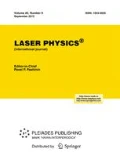Abstract
A simple mechanism for the formation of a chain of voids (cavities) behind the spot of the laser optical discharge in an optical fiber is proposed. This mechanism is related to the motion of liquid in the opposite direction with respect to the propagation direction of the laser radiation between the isotherms that bound the charge-separation region and low-viscosity region. The motion is caused by the extrusion of the low-viscosity layer owing to the excessive pressure induced by the charge repulsion. The void shape (a bullet moving along the laser radiation) is determined by the isotherm sharpness. The bridge formation temperature (about 5000 K) is estimated based on the comparison of the extrusion velocity of the low-viscosity layer and the velocity of the bright spot.
Similar content being viewed by others
References
R. Kashyap and K. J. Blow, Electron. Lett. 24(1), 47 (1988).
R. M. Atkins, P. G. Simpkins, and A. D. Yablon, “Track of Fiber Fuse: A Rayleigh Instability in Optical Waveguides,” Opt. Lett. 28, 974 (2003).
I. A. Bufetov, A. A. Frolov, E. M. Dianov, et al., “Dynamics of Fiber Fuse Propagation,” in Proceedings of Optical Fiber Communication Conference and Exposition and the National Fiber Optic Engineers Conference (OFC/NFOEC), Anaheim, 2005 (Anaheim, 2005).
S. Todoroki, “Ultrahigh-Speed Videography of Fiber Fuse Propagation: A Tool for Studying Void Formation,” in Proceedings of International Conference on Coherent and Nonlinear Optics (ICONO) and Lasers, Applications, and Technologies (LAT), St. Petersburg, Russia, 2005 (St. Petersburg, 2005).
S. I. Yakovlenko, Kvantovaya Elektron. (Moscow) 34(8), 765 (2004) [Quantum Electron. 34, 787 (2004)].
E. Yurkov and S. I. Yakovlenko, Kratk. Soobshch. Fiz., No. 11, 21 (2004).
E. Yurkov and S. I. Yakovlenko, Kratk. Soobshch. Fiz., No. 5 (2005).
Lord Rayleigh, Nature 95, 66 (1915).
S. Chandrasekhar, Hydrodynamic and Hydromagnetic Stability (Oxford Univ. Press, Oxford, 1961).
L. D. Landau and E. M. Lifshitz, Fluid Mechanics, 2nd ed. (Nauka, Moscow, 1986; Pergamon Press, Oxford, 1987).
R. I. Golyatina, A. N. Tkachev, and S. I. Yakovlenko, Laser Phys. 14(11), 1429 (2004).
R. I. Golyatina, A. N. Tkachev, and S. I. Yakovlenko, Zh. Tekh. Fiz. 75(2), 94 (2005) [Tech. Phys. 50, 232 (2005)].
A. N. Tkachev and S. I. Yakovlenko, Kvantovaya Elektron. (Moscow) 34(8), 761 (2004) [Quantum Electron. 34, 761 (2004)].
D. P. Hand and P. St. J. Russel, Opt. Lett. 13(9), 767 (1988).
Author information
Authors and Affiliations
Additional information
Original Text © Astro, Ltd., 2006.



